Principles of Pharmacology and Therapeutics: Warfarin Analysis
VerifiedAdded on 2023/03/20
|27
|5009
|66
Report
AI Summary
This report provides a detailed analysis of Warfarin, a widely used anticoagulant medication. The report begins by classifying Warfarin within the ATC system and outlining its indications, which include the prevention and treatment of venous thrombosis, thromboembolic complications, and reduction of stroke risk. The report then presents studies evaluating Warfarin's effectiveness in ischemic stroke patients with atrial fibrillation and compares it to alternative therapies. The report contrasts Warfarin with Heparin, highlighting their mechanisms of action, administration routes, and clinical uses. Furthermore, it examines the pharmacokinetic properties of Warfarin, including absorption, metabolism, and half-life, and compares these aspects to Heparin, explaining their implications for drug use and clinical outcomes. The report emphasizes the importance of monitoring Warfarin therapy through INR testing and discusses factors that can influence INR levels. The report concludes with a discussion of the clinical aspects of Warfarin use, including dosing and administration, speed of onset and offset of effect, and who can use the drug.

Running head: PRINCIPLES OF PHARMACOLOGY AND THERAPEUTICS 1
Principles of Pharmacology and Therapeutics
Name of Author
Institution of Affiliation
Date of Submission
Principles of Pharmacology and Therapeutics
Name of Author
Institution of Affiliation
Date of Submission
Paraphrase This Document
Need a fresh take? Get an instant paraphrase of this document with our AI Paraphraser
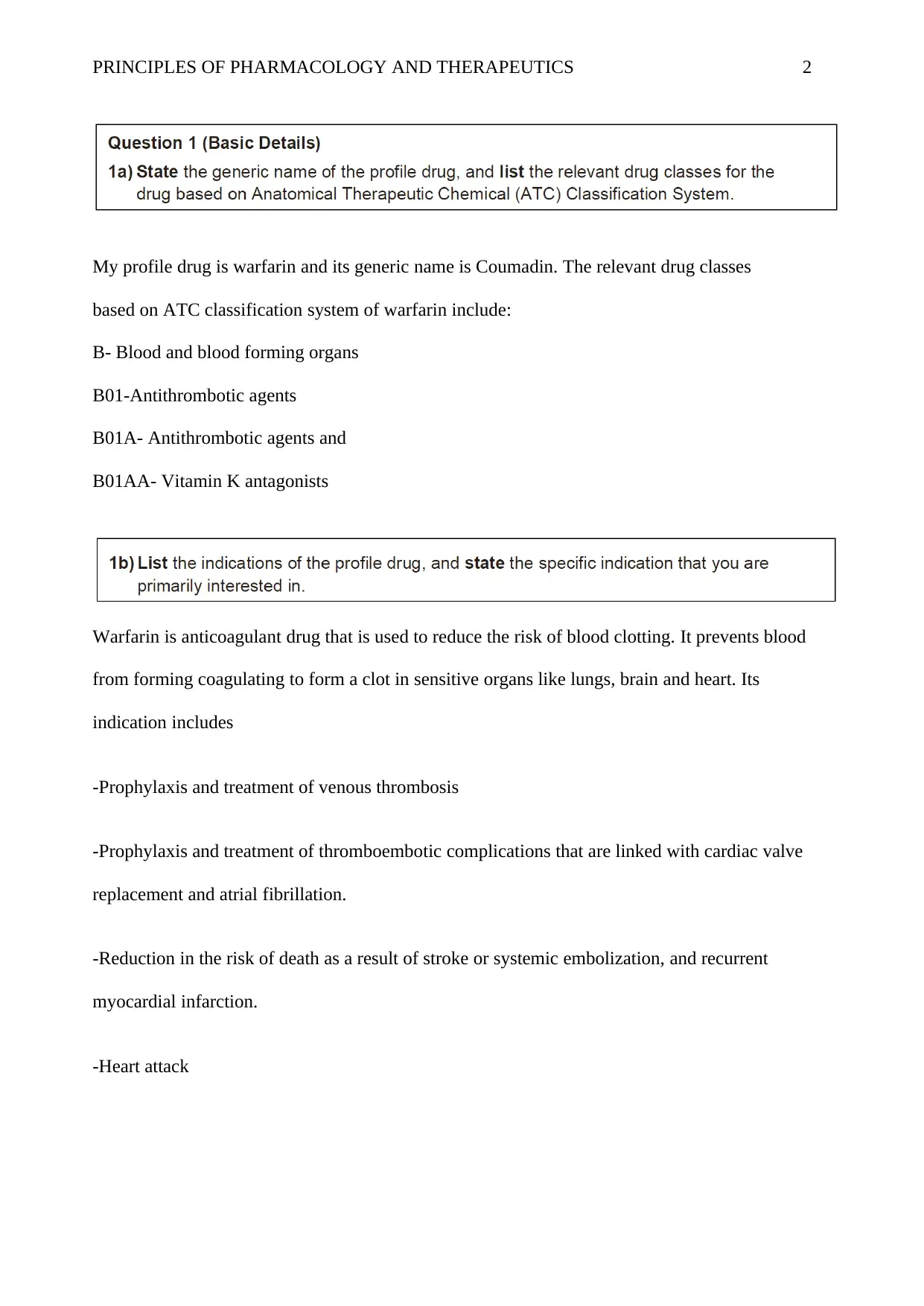
PRINCIPLES OF PHARMACOLOGY AND THERAPEUTICS 2
My profile drug is warfarin and its generic name is Coumadin. The relevant drug classes
based on ATC classification system of warfarin include:
B- Blood and blood forming organs
B01-Antithrombotic agents
B01A- Antithrombotic agents and
B01AA- Vitamin K antagonists
Warfarin is anticoagulant drug that is used to reduce the risk of blood clotting. It prevents blood
from forming coagulating to form a clot in sensitive organs like lungs, brain and heart. Its
indication includes
-Prophylaxis and treatment of venous thrombosis
-Prophylaxis and treatment of thromboembotic complications that are linked with cardiac valve
replacement and atrial fibrillation.
-Reduction in the risk of death as a result of stroke or systemic embolization, and recurrent
myocardial infarction.
-Heart attack
My profile drug is warfarin and its generic name is Coumadin. The relevant drug classes
based on ATC classification system of warfarin include:
B- Blood and blood forming organs
B01-Antithrombotic agents
B01A- Antithrombotic agents and
B01AA- Vitamin K antagonists
Warfarin is anticoagulant drug that is used to reduce the risk of blood clotting. It prevents blood
from forming coagulating to form a clot in sensitive organs like lungs, brain and heart. Its
indication includes
-Prophylaxis and treatment of venous thrombosis
-Prophylaxis and treatment of thromboembotic complications that are linked with cardiac valve
replacement and atrial fibrillation.
-Reduction in the risk of death as a result of stroke or systemic embolization, and recurrent
myocardial infarction.
-Heart attack
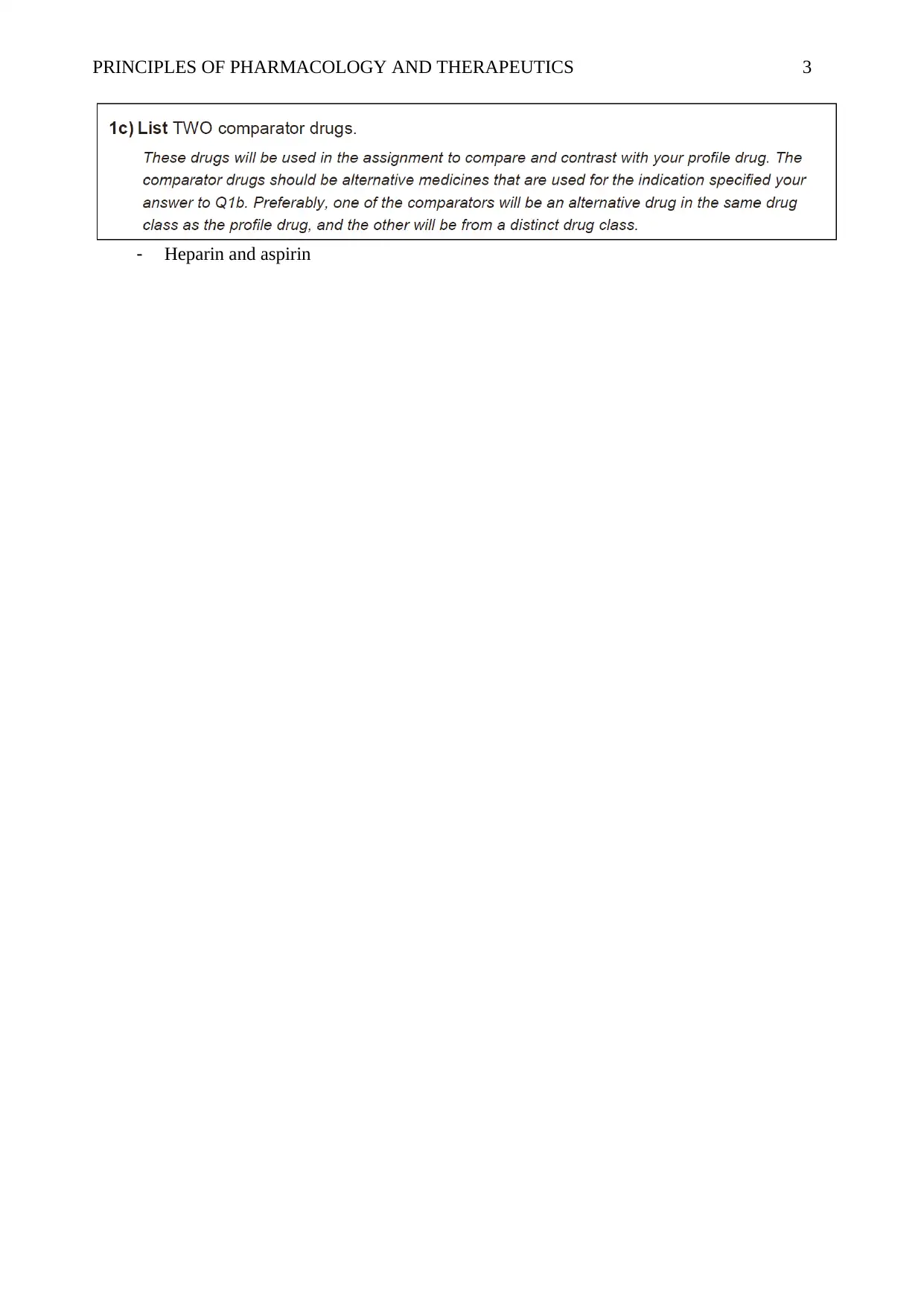
PRINCIPLES OF PHARMACOLOGY AND THERAPEUTICS 3
- Heparin and aspirin
- Heparin and aspirin
⊘ This is a preview!⊘
Do you want full access?
Subscribe today to unlock all pages.

Trusted by 1+ million students worldwide
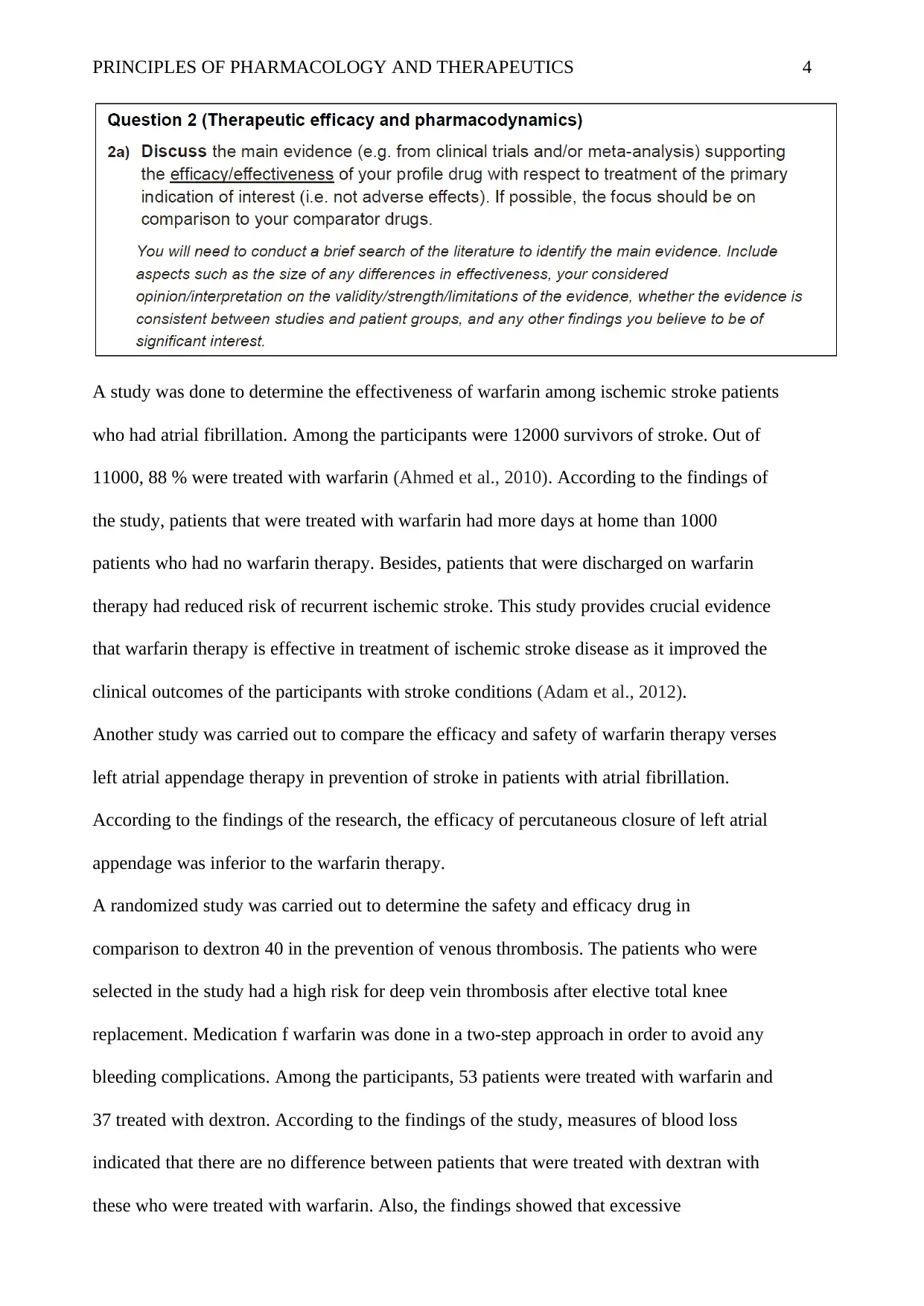
PRINCIPLES OF PHARMACOLOGY AND THERAPEUTICS 4
A study was done to determine the effectiveness of warfarin among ischemic stroke patients
who had atrial fibrillation. Among the participants were 12000 survivors of stroke. Out of
11000, 88 % were treated with warfarin (Ahmed et al., 2010). According to the findings of
the study, patients that were treated with warfarin had more days at home than 1000
patients who had no warfarin therapy. Besides, patients that were discharged on warfarin
therapy had reduced risk of recurrent ischemic stroke. This study provides crucial evidence
that warfarin therapy is effective in treatment of ischemic stroke disease as it improved the
clinical outcomes of the participants with stroke conditions (Adam et al., 2012).
Another study was carried out to compare the efficacy and safety of warfarin therapy verses
left atrial appendage therapy in prevention of stroke in patients with atrial fibrillation.
According to the findings of the research, the efficacy of percutaneous closure of left atrial
appendage was inferior to the warfarin therapy.
A randomized study was carried out to determine the safety and efficacy drug in
comparison to dextron 40 in the prevention of venous thrombosis. The patients who were
selected in the study had a high risk for deep vein thrombosis after elective total knee
replacement. Medication f warfarin was done in a two-step approach in order to avoid any
bleeding complications. Among the participants, 53 patients were treated with warfarin and
37 treated with dextron. According to the findings of the study, measures of blood loss
indicated that there are no difference between patients that were treated with dextran with
these who were treated with warfarin. Also, the findings showed that excessive
A study was done to determine the effectiveness of warfarin among ischemic stroke patients
who had atrial fibrillation. Among the participants were 12000 survivors of stroke. Out of
11000, 88 % were treated with warfarin (Ahmed et al., 2010). According to the findings of
the study, patients that were treated with warfarin had more days at home than 1000
patients who had no warfarin therapy. Besides, patients that were discharged on warfarin
therapy had reduced risk of recurrent ischemic stroke. This study provides crucial evidence
that warfarin therapy is effective in treatment of ischemic stroke disease as it improved the
clinical outcomes of the participants with stroke conditions (Adam et al., 2012).
Another study was carried out to compare the efficacy and safety of warfarin therapy verses
left atrial appendage therapy in prevention of stroke in patients with atrial fibrillation.
According to the findings of the research, the efficacy of percutaneous closure of left atrial
appendage was inferior to the warfarin therapy.
A randomized study was carried out to determine the safety and efficacy drug in
comparison to dextron 40 in the prevention of venous thrombosis. The patients who were
selected in the study had a high risk for deep vein thrombosis after elective total knee
replacement. Medication f warfarin was done in a two-step approach in order to avoid any
bleeding complications. Among the participants, 53 patients were treated with warfarin and
37 treated with dextron. According to the findings of the study, measures of blood loss
indicated that there are no difference between patients that were treated with dextran with
these who were treated with warfarin. Also, the findings showed that excessive
Paraphrase This Document
Need a fresh take? Get an instant paraphrase of this document with our AI Paraphraser
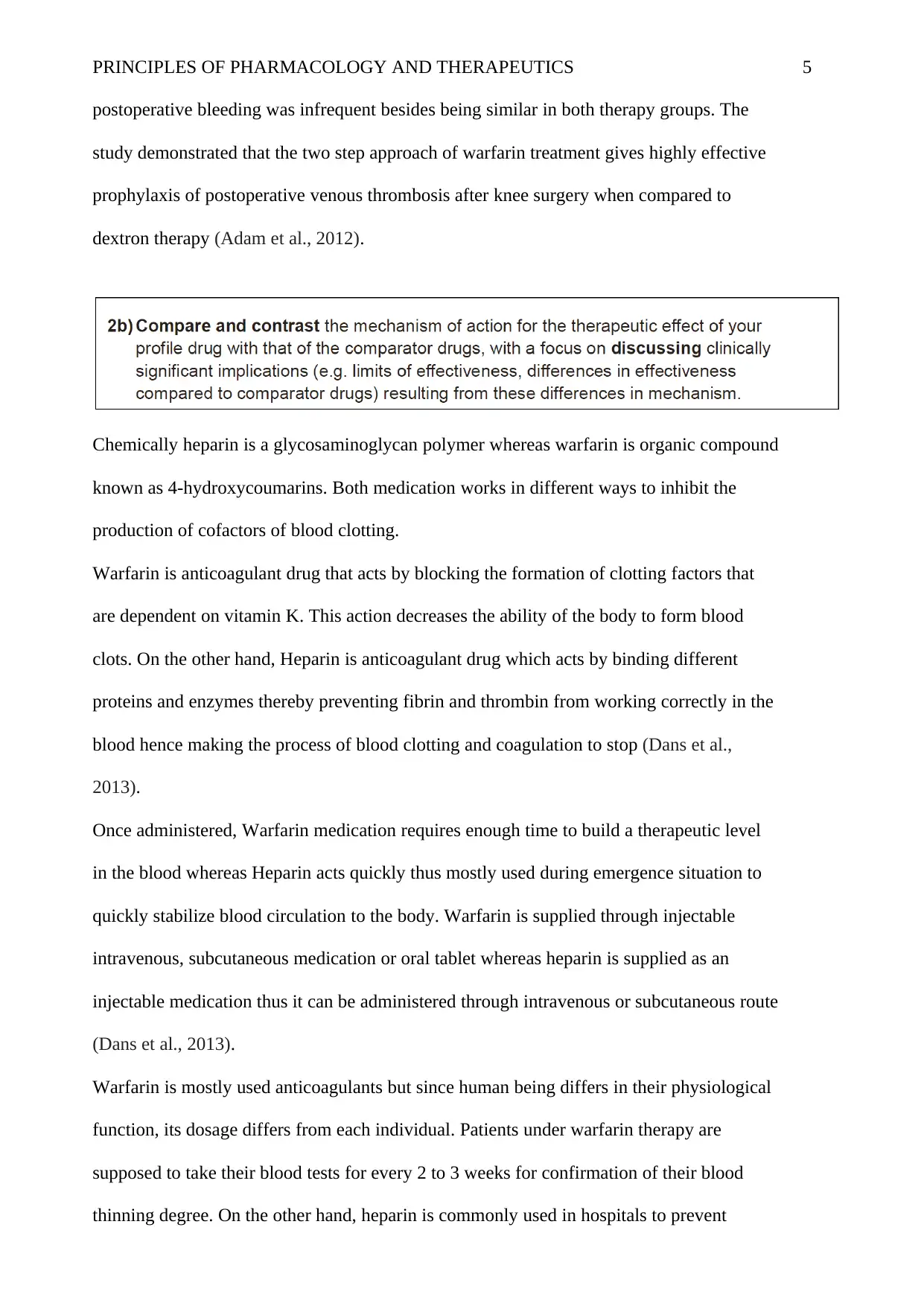
PRINCIPLES OF PHARMACOLOGY AND THERAPEUTICS 5
postoperative bleeding was infrequent besides being similar in both therapy groups. The
study demonstrated that the two step approach of warfarin treatment gives highly effective
prophylaxis of postoperative venous thrombosis after knee surgery when compared to
dextron therapy (Adam et al., 2012).
Chemically heparin is a glycosaminoglycan polymer whereas warfarin is organic compound
known as 4-hydroxycoumarins. Both medication works in different ways to inhibit the
production of cofactors of blood clotting.
Warfarin is anticoagulant drug that acts by blocking the formation of clotting factors that
are dependent on vitamin K. This action decreases the ability of the body to form blood
clots. On the other hand, Heparin is anticoagulant drug which acts by binding different
proteins and enzymes thereby preventing fibrin and thrombin from working correctly in the
blood hence making the process of blood clotting and coagulation to stop (Dans et al.,
2013).
Once administered, Warfarin medication requires enough time to build a therapeutic level
in the blood whereas Heparin acts quickly thus mostly used during emergence situation to
quickly stabilize blood circulation to the body. Warfarin is supplied through injectable
intravenous, subcutaneous medication or oral tablet whereas heparin is supplied as an
injectable medication thus it can be administered through intravenous or subcutaneous route
(Dans et al., 2013).
Warfarin is mostly used anticoagulants but since human being differs in their physiological
function, its dosage differs from each individual. Patients under warfarin therapy are
supposed to take their blood tests for every 2 to 3 weeks for confirmation of their blood
thinning degree. On the other hand, heparin is commonly used in hospitals to prevent
postoperative bleeding was infrequent besides being similar in both therapy groups. The
study demonstrated that the two step approach of warfarin treatment gives highly effective
prophylaxis of postoperative venous thrombosis after knee surgery when compared to
dextron therapy (Adam et al., 2012).
Chemically heparin is a glycosaminoglycan polymer whereas warfarin is organic compound
known as 4-hydroxycoumarins. Both medication works in different ways to inhibit the
production of cofactors of blood clotting.
Warfarin is anticoagulant drug that acts by blocking the formation of clotting factors that
are dependent on vitamin K. This action decreases the ability of the body to form blood
clots. On the other hand, Heparin is anticoagulant drug which acts by binding different
proteins and enzymes thereby preventing fibrin and thrombin from working correctly in the
blood hence making the process of blood clotting and coagulation to stop (Dans et al.,
2013).
Once administered, Warfarin medication requires enough time to build a therapeutic level
in the blood whereas Heparin acts quickly thus mostly used during emergence situation to
quickly stabilize blood circulation to the body. Warfarin is supplied through injectable
intravenous, subcutaneous medication or oral tablet whereas heparin is supplied as an
injectable medication thus it can be administered through intravenous or subcutaneous route
(Dans et al., 2013).
Warfarin is mostly used anticoagulants but since human being differs in their physiological
function, its dosage differs from each individual. Patients under warfarin therapy are
supposed to take their blood tests for every 2 to 3 weeks for confirmation of their blood
thinning degree. On the other hand, heparin is commonly used in hospitals to prevent
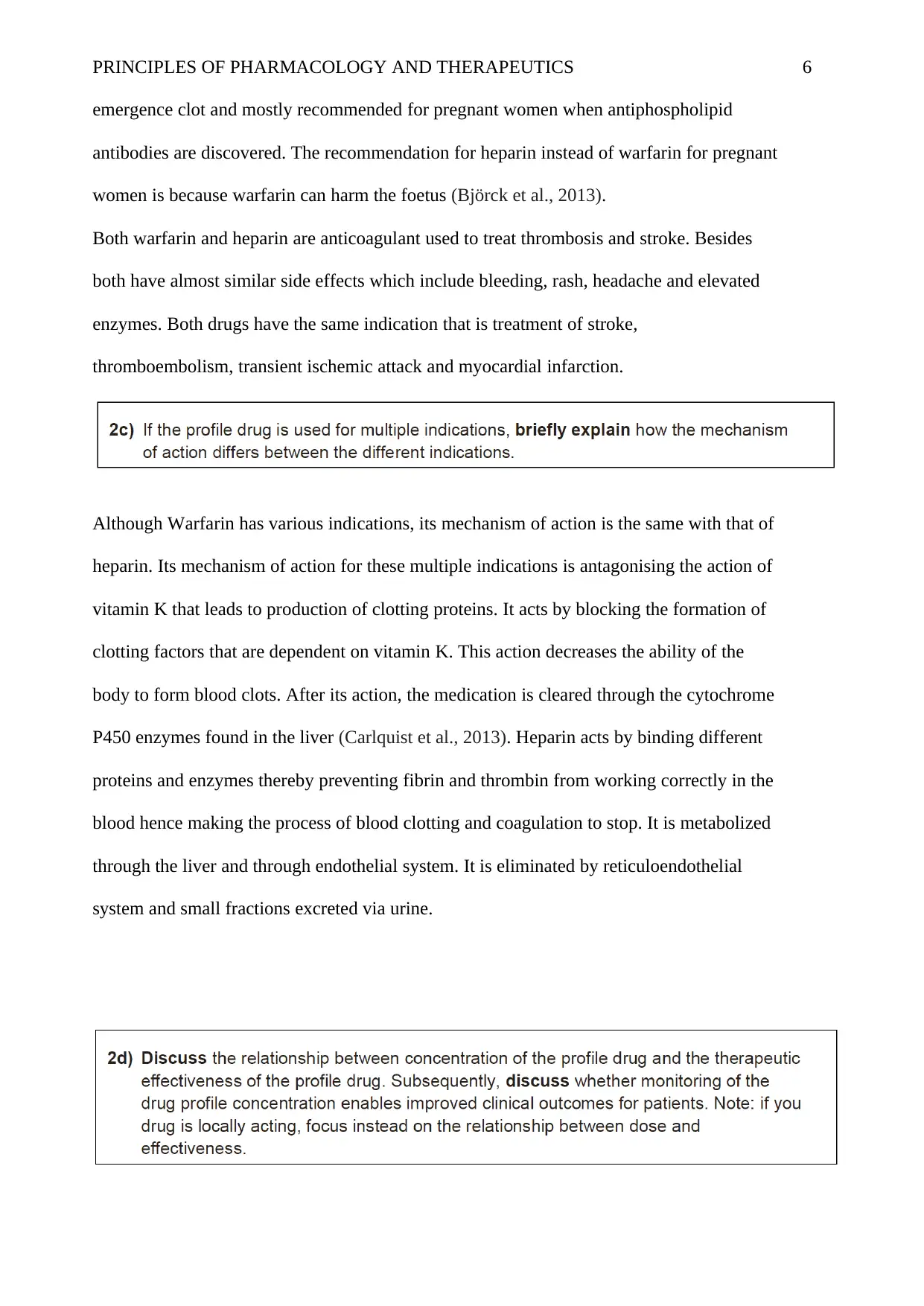
PRINCIPLES OF PHARMACOLOGY AND THERAPEUTICS 6
emergence clot and mostly recommended for pregnant women when antiphospholipid
antibodies are discovered. The recommendation for heparin instead of warfarin for pregnant
women is because warfarin can harm the foetus (Björck et al., 2013).
Both warfarin and heparin are anticoagulant used to treat thrombosis and stroke. Besides
both have almost similar side effects which include bleeding, rash, headache and elevated
enzymes. Both drugs have the same indication that is treatment of stroke,
thromboembolism, transient ischemic attack and myocardial infarction.
Although Warfarin has various indications, its mechanism of action is the same with that of
heparin. Its mechanism of action for these multiple indications is antagonising the action of
vitamin K that leads to production of clotting proteins. It acts by blocking the formation of
clotting factors that are dependent on vitamin K. This action decreases the ability of the
body to form blood clots. After its action, the medication is cleared through the cytochrome
P450 enzymes found in the liver (Carlquist et al., 2013). Heparin acts by binding different
proteins and enzymes thereby preventing fibrin and thrombin from working correctly in the
blood hence making the process of blood clotting and coagulation to stop. It is metabolized
through the liver and through endothelial system. It is eliminated by reticuloendothelial
system and small fractions excreted via urine.
emergence clot and mostly recommended for pregnant women when antiphospholipid
antibodies are discovered. The recommendation for heparin instead of warfarin for pregnant
women is because warfarin can harm the foetus (Björck et al., 2013).
Both warfarin and heparin are anticoagulant used to treat thrombosis and stroke. Besides
both have almost similar side effects which include bleeding, rash, headache and elevated
enzymes. Both drugs have the same indication that is treatment of stroke,
thromboembolism, transient ischemic attack and myocardial infarction.
Although Warfarin has various indications, its mechanism of action is the same with that of
heparin. Its mechanism of action for these multiple indications is antagonising the action of
vitamin K that leads to production of clotting proteins. It acts by blocking the formation of
clotting factors that are dependent on vitamin K. This action decreases the ability of the
body to form blood clots. After its action, the medication is cleared through the cytochrome
P450 enzymes found in the liver (Carlquist et al., 2013). Heparin acts by binding different
proteins and enzymes thereby preventing fibrin and thrombin from working correctly in the
blood hence making the process of blood clotting and coagulation to stop. It is metabolized
through the liver and through endothelial system. It is eliminated by reticuloendothelial
system and small fractions excreted via urine.
⊘ This is a preview!⊘
Do you want full access?
Subscribe today to unlock all pages.

Trusted by 1+ million students worldwide
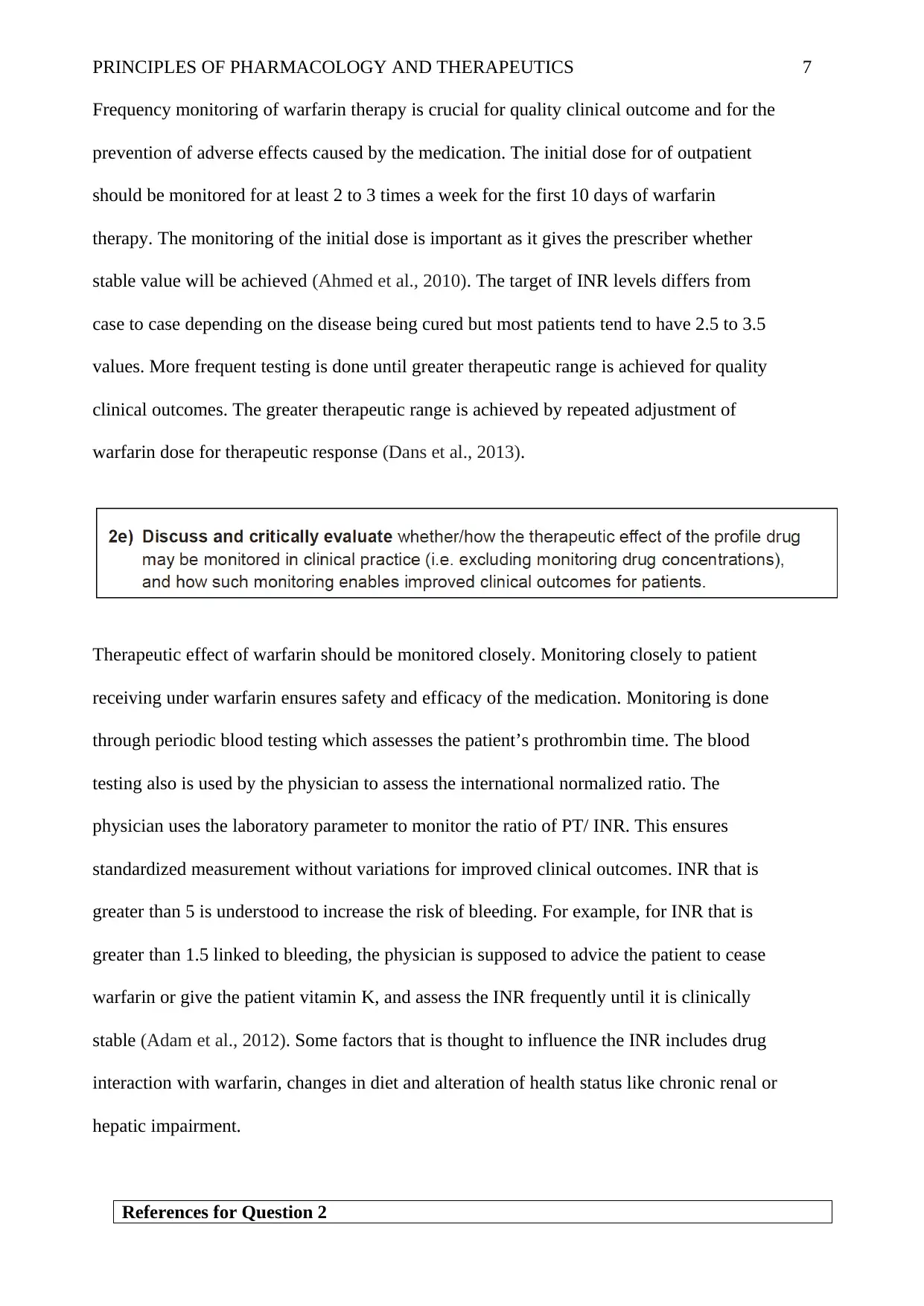
PRINCIPLES OF PHARMACOLOGY AND THERAPEUTICS 7
Frequency monitoring of warfarin therapy is crucial for quality clinical outcome and for the
prevention of adverse effects caused by the medication. The initial dose for of outpatient
should be monitored for at least 2 to 3 times a week for the first 10 days of warfarin
therapy. The monitoring of the initial dose is important as it gives the prescriber whether
stable value will be achieved (Ahmed et al., 2010). The target of INR levels differs from
case to case depending on the disease being cured but most patients tend to have 2.5 to 3.5
values. More frequent testing is done until greater therapeutic range is achieved for quality
clinical outcomes. The greater therapeutic range is achieved by repeated adjustment of
warfarin dose for therapeutic response (Dans et al., 2013).
Therapeutic effect of warfarin should be monitored closely. Monitoring closely to patient
receiving under warfarin ensures safety and efficacy of the medication. Monitoring is done
through periodic blood testing which assesses the patient’s prothrombin time. The blood
testing also is used by the physician to assess the international normalized ratio. The
physician uses the laboratory parameter to monitor the ratio of PT/ INR. This ensures
standardized measurement without variations for improved clinical outcomes. INR that is
greater than 5 is understood to increase the risk of bleeding. For example, for INR that is
greater than 1.5 linked to bleeding, the physician is supposed to advice the patient to cease
warfarin or give the patient vitamin K, and assess the INR frequently until it is clinically
stable (Adam et al., 2012). Some factors that is thought to influence the INR includes drug
interaction with warfarin, changes in diet and alteration of health status like chronic renal or
hepatic impairment.
References for Question 2
Frequency monitoring of warfarin therapy is crucial for quality clinical outcome and for the
prevention of adverse effects caused by the medication. The initial dose for of outpatient
should be monitored for at least 2 to 3 times a week for the first 10 days of warfarin
therapy. The monitoring of the initial dose is important as it gives the prescriber whether
stable value will be achieved (Ahmed et al., 2010). The target of INR levels differs from
case to case depending on the disease being cured but most patients tend to have 2.5 to 3.5
values. More frequent testing is done until greater therapeutic range is achieved for quality
clinical outcomes. The greater therapeutic range is achieved by repeated adjustment of
warfarin dose for therapeutic response (Dans et al., 2013).
Therapeutic effect of warfarin should be monitored closely. Monitoring closely to patient
receiving under warfarin ensures safety and efficacy of the medication. Monitoring is done
through periodic blood testing which assesses the patient’s prothrombin time. The blood
testing also is used by the physician to assess the international normalized ratio. The
physician uses the laboratory parameter to monitor the ratio of PT/ INR. This ensures
standardized measurement without variations for improved clinical outcomes. INR that is
greater than 5 is understood to increase the risk of bleeding. For example, for INR that is
greater than 1.5 linked to bleeding, the physician is supposed to advice the patient to cease
warfarin or give the patient vitamin K, and assess the INR frequently until it is clinically
stable (Adam et al., 2012). Some factors that is thought to influence the INR includes drug
interaction with warfarin, changes in diet and alteration of health status like chronic renal or
hepatic impairment.
References for Question 2
Paraphrase This Document
Need a fresh take? Get an instant paraphrase of this document with our AI Paraphraser
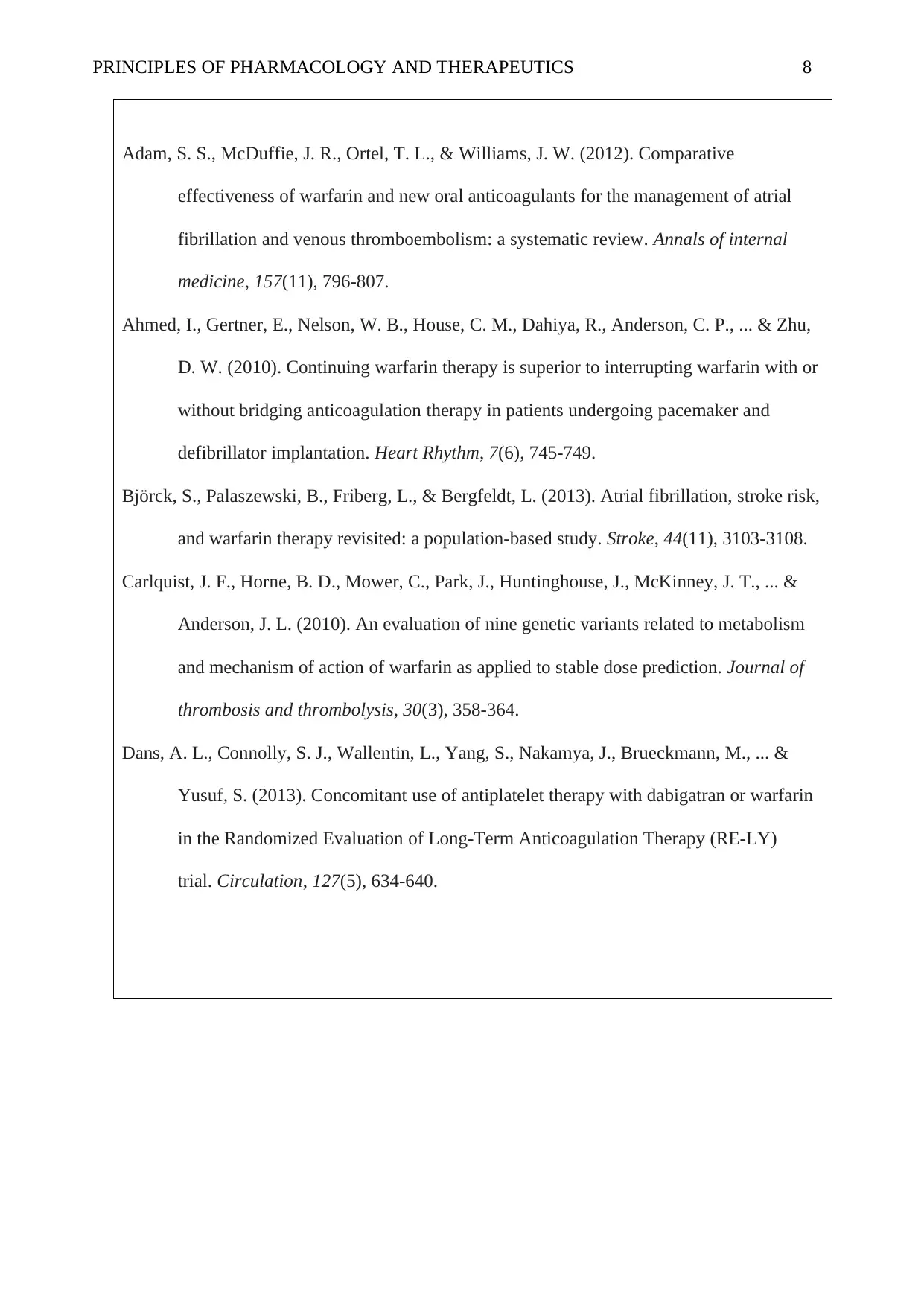
PRINCIPLES OF PHARMACOLOGY AND THERAPEUTICS 8
Adam, S. S., McDuffie, J. R., Ortel, T. L., & Williams, J. W. (2012). Comparative
effectiveness of warfarin and new oral anticoagulants for the management of atrial
fibrillation and venous thromboembolism: a systematic review. Annals of internal
medicine, 157(11), 796-807.
Ahmed, I., Gertner, E., Nelson, W. B., House, C. M., Dahiya, R., Anderson, C. P., ... & Zhu,
D. W. (2010). Continuing warfarin therapy is superior to interrupting warfarin with or
without bridging anticoagulation therapy in patients undergoing pacemaker and
defibrillator implantation. Heart Rhythm, 7(6), 745-749.
Björck, S., Palaszewski, B., Friberg, L., & Bergfeldt, L. (2013). Atrial fibrillation, stroke risk,
and warfarin therapy revisited: a population-based study. Stroke, 44(11), 3103-3108.
Carlquist, J. F., Horne, B. D., Mower, C., Park, J., Huntinghouse, J., McKinney, J. T., ... &
Anderson, J. L. (2010). An evaluation of nine genetic variants related to metabolism
and mechanism of action of warfarin as applied to stable dose prediction. Journal of
thrombosis and thrombolysis, 30(3), 358-364.
Dans, A. L., Connolly, S. J., Wallentin, L., Yang, S., Nakamya, J., Brueckmann, M., ... &
Yusuf, S. (2013). Concomitant use of antiplatelet therapy with dabigatran or warfarin
in the Randomized Evaluation of Long-Term Anticoagulation Therapy (RE-LY)
trial. Circulation, 127(5), 634-640.
Adam, S. S., McDuffie, J. R., Ortel, T. L., & Williams, J. W. (2012). Comparative
effectiveness of warfarin and new oral anticoagulants for the management of atrial
fibrillation and venous thromboembolism: a systematic review. Annals of internal
medicine, 157(11), 796-807.
Ahmed, I., Gertner, E., Nelson, W. B., House, C. M., Dahiya, R., Anderson, C. P., ... & Zhu,
D. W. (2010). Continuing warfarin therapy is superior to interrupting warfarin with or
without bridging anticoagulation therapy in patients undergoing pacemaker and
defibrillator implantation. Heart Rhythm, 7(6), 745-749.
Björck, S., Palaszewski, B., Friberg, L., & Bergfeldt, L. (2013). Atrial fibrillation, stroke risk,
and warfarin therapy revisited: a population-based study. Stroke, 44(11), 3103-3108.
Carlquist, J. F., Horne, B. D., Mower, C., Park, J., Huntinghouse, J., McKinney, J. T., ... &
Anderson, J. L. (2010). An evaluation of nine genetic variants related to metabolism
and mechanism of action of warfarin as applied to stable dose prediction. Journal of
thrombosis and thrombolysis, 30(3), 358-364.
Dans, A. L., Connolly, S. J., Wallentin, L., Yang, S., Nakamya, J., Brueckmann, M., ... &
Yusuf, S. (2013). Concomitant use of antiplatelet therapy with dabigatran or warfarin
in the Randomized Evaluation of Long-Term Anticoagulation Therapy (RE-LY)
trial. Circulation, 127(5), 634-640.
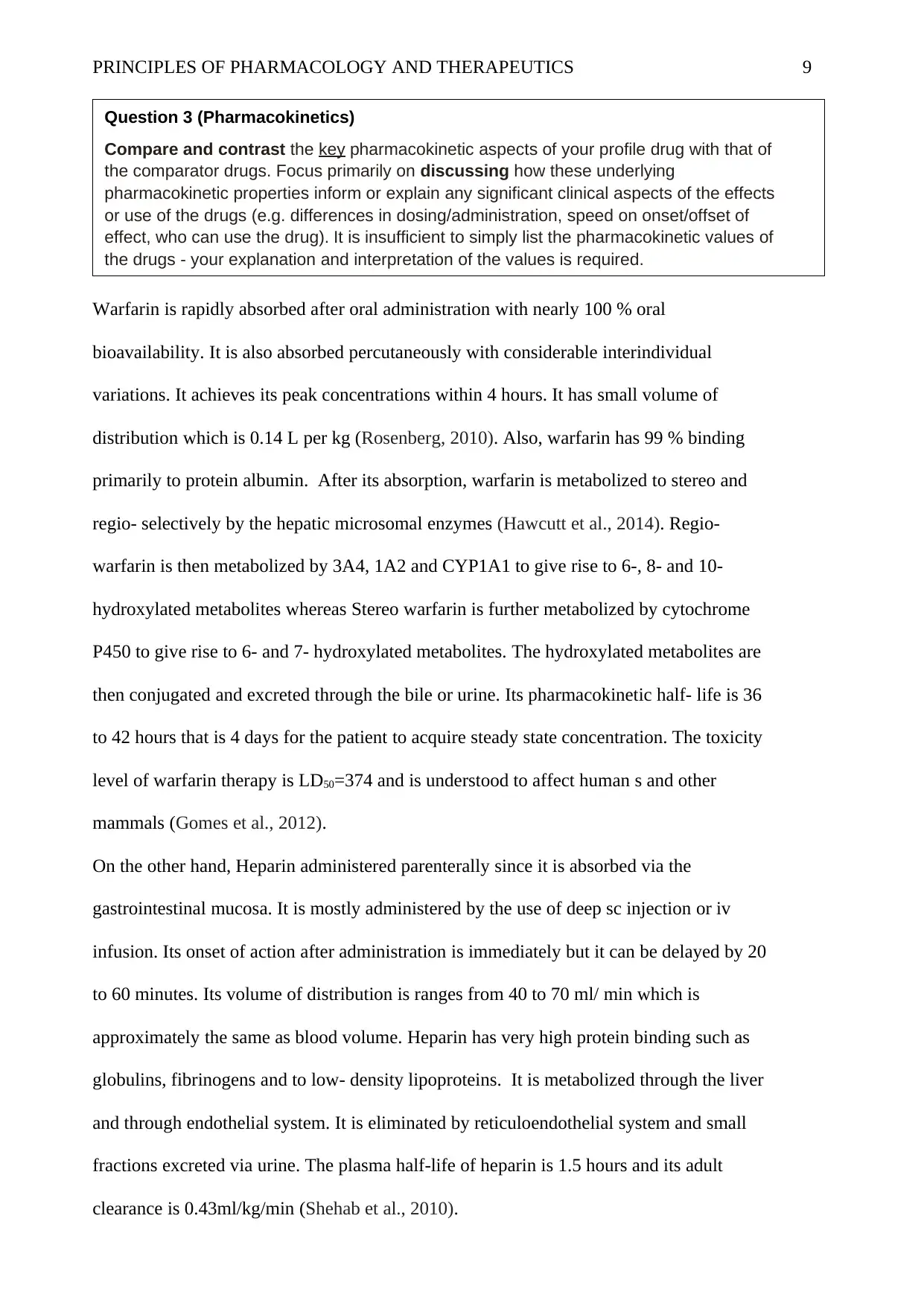
PRINCIPLES OF PHARMACOLOGY AND THERAPEUTICS 9
Question 3 (Pharmacokinetics)
Compare and contrast the key pharmacokinetic aspects of your profile drug with that of
the comparator drugs. Focus primarily on discussing how these underlying
pharmacokinetic properties inform or explain any significant clinical aspects of the effects
or use of the drugs (e.g. differences in dosing/administration, speed on onset/offset of
effect, who can use the drug). It is insufficient to simply list the pharmacokinetic values of
the drugs - your explanation and interpretation of the values is required.
Warfarin is rapidly absorbed after oral administration with nearly 100 % oral
bioavailability. It is also absorbed percutaneously with considerable interindividual
variations. It achieves its peak concentrations within 4 hours. It has small volume of
distribution which is 0.14 L per kg (Rosenberg, 2010). Also, warfarin has 99 % binding
primarily to protein albumin. After its absorption, warfarin is metabolized to stereo and
regio- selectively by the hepatic microsomal enzymes (Hawcutt et al., 2014). Regio-
warfarin is then metabolized by 3A4, 1A2 and CYP1A1 to give rise to 6-, 8- and 10-
hydroxylated metabolites whereas Stereo warfarin is further metabolized by cytochrome
P450 to give rise to 6- and 7- hydroxylated metabolites. The hydroxylated metabolites are
then conjugated and excreted through the bile or urine. Its pharmacokinetic half- life is 36
to 42 hours that is 4 days for the patient to acquire steady state concentration. The toxicity
level of warfarin therapy is LD50=374 and is understood to affect human s and other
mammals (Gomes et al., 2012).
On the other hand, Heparin administered parenterally since it is absorbed via the
gastrointestinal mucosa. It is mostly administered by the use of deep sc injection or iv
infusion. Its onset of action after administration is immediately but it can be delayed by 20
to 60 minutes. Its volume of distribution is ranges from 40 to 70 ml/ min which is
approximately the same as blood volume. Heparin has very high protein binding such as
globulins, fibrinogens and to low- density lipoproteins. It is metabolized through the liver
and through endothelial system. It is eliminated by reticuloendothelial system and small
fractions excreted via urine. The plasma half-life of heparin is 1.5 hours and its adult
clearance is 0.43ml/kg/min (Shehab et al., 2010).
Question 3 (Pharmacokinetics)
Compare and contrast the key pharmacokinetic aspects of your profile drug with that of
the comparator drugs. Focus primarily on discussing how these underlying
pharmacokinetic properties inform or explain any significant clinical aspects of the effects
or use of the drugs (e.g. differences in dosing/administration, speed on onset/offset of
effect, who can use the drug). It is insufficient to simply list the pharmacokinetic values of
the drugs - your explanation and interpretation of the values is required.
Warfarin is rapidly absorbed after oral administration with nearly 100 % oral
bioavailability. It is also absorbed percutaneously with considerable interindividual
variations. It achieves its peak concentrations within 4 hours. It has small volume of
distribution which is 0.14 L per kg (Rosenberg, 2010). Also, warfarin has 99 % binding
primarily to protein albumin. After its absorption, warfarin is metabolized to stereo and
regio- selectively by the hepatic microsomal enzymes (Hawcutt et al., 2014). Regio-
warfarin is then metabolized by 3A4, 1A2 and CYP1A1 to give rise to 6-, 8- and 10-
hydroxylated metabolites whereas Stereo warfarin is further metabolized by cytochrome
P450 to give rise to 6- and 7- hydroxylated metabolites. The hydroxylated metabolites are
then conjugated and excreted through the bile or urine. Its pharmacokinetic half- life is 36
to 42 hours that is 4 days for the patient to acquire steady state concentration. The toxicity
level of warfarin therapy is LD50=374 and is understood to affect human s and other
mammals (Gomes et al., 2012).
On the other hand, Heparin administered parenterally since it is absorbed via the
gastrointestinal mucosa. It is mostly administered by the use of deep sc injection or iv
infusion. Its onset of action after administration is immediately but it can be delayed by 20
to 60 minutes. Its volume of distribution is ranges from 40 to 70 ml/ min which is
approximately the same as blood volume. Heparin has very high protein binding such as
globulins, fibrinogens and to low- density lipoproteins. It is metabolized through the liver
and through endothelial system. It is eliminated by reticuloendothelial system and small
fractions excreted via urine. The plasma half-life of heparin is 1.5 hours and its adult
clearance is 0.43ml/kg/min (Shehab et al., 2010).
⊘ This is a preview!⊘
Do you want full access?
Subscribe today to unlock all pages.

Trusted by 1+ million students worldwide
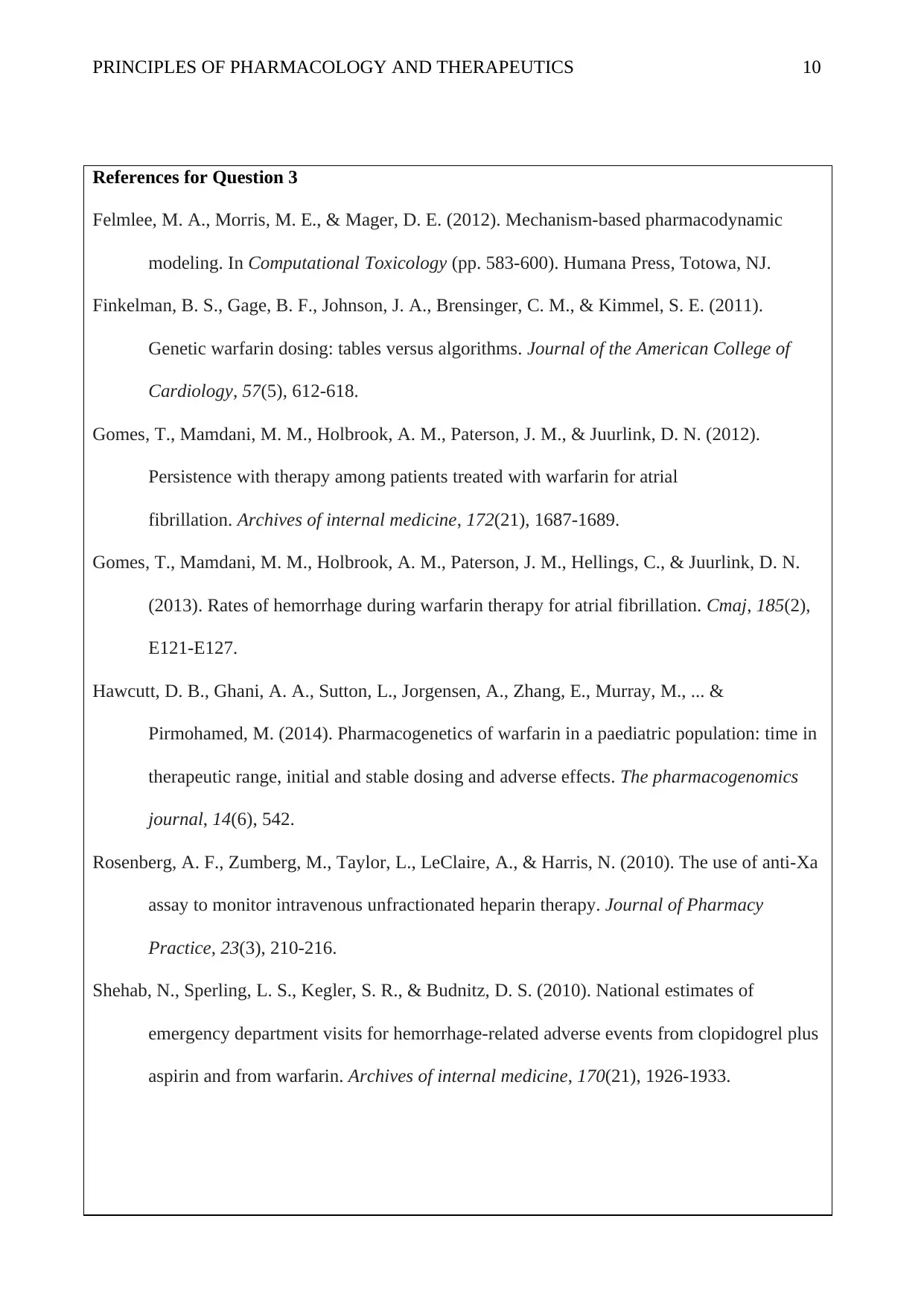
PRINCIPLES OF PHARMACOLOGY AND THERAPEUTICS 10
References for Question 3
Felmlee, M. A., Morris, M. E., & Mager, D. E. (2012). Mechanism-based pharmacodynamic
modeling. In Computational Toxicology (pp. 583-600). Humana Press, Totowa, NJ.
Finkelman, B. S., Gage, B. F., Johnson, J. A., Brensinger, C. M., & Kimmel, S. E. (2011).
Genetic warfarin dosing: tables versus algorithms. Journal of the American College of
Cardiology, 57(5), 612-618.
Gomes, T., Mamdani, M. M., Holbrook, A. M., Paterson, J. M., & Juurlink, D. N. (2012).
Persistence with therapy among patients treated with warfarin for atrial
fibrillation. Archives of internal medicine, 172(21), 1687-1689.
Gomes, T., Mamdani, M. M., Holbrook, A. M., Paterson, J. M., Hellings, C., & Juurlink, D. N.
(2013). Rates of hemorrhage during warfarin therapy for atrial fibrillation. Cmaj, 185(2),
E121-E127.
Hawcutt, D. B., Ghani, A. A., Sutton, L., Jorgensen, A., Zhang, E., Murray, M., ... &
Pirmohamed, M. (2014). Pharmacogenetics of warfarin in a paediatric population: time in
therapeutic range, initial and stable dosing and adverse effects. The pharmacogenomics
journal, 14(6), 542.
Rosenberg, A. F., Zumberg, M., Taylor, L., LeClaire, A., & Harris, N. (2010). The use of anti-Xa
assay to monitor intravenous unfractionated heparin therapy. Journal of Pharmacy
Practice, 23(3), 210-216.
Shehab, N., Sperling, L. S., Kegler, S. R., & Budnitz, D. S. (2010). National estimates of
emergency department visits for hemorrhage-related adverse events from clopidogrel plus
aspirin and from warfarin. Archives of internal medicine, 170(21), 1926-1933.
References for Question 3
Felmlee, M. A., Morris, M. E., & Mager, D. E. (2012). Mechanism-based pharmacodynamic
modeling. In Computational Toxicology (pp. 583-600). Humana Press, Totowa, NJ.
Finkelman, B. S., Gage, B. F., Johnson, J. A., Brensinger, C. M., & Kimmel, S. E. (2011).
Genetic warfarin dosing: tables versus algorithms. Journal of the American College of
Cardiology, 57(5), 612-618.
Gomes, T., Mamdani, M. M., Holbrook, A. M., Paterson, J. M., & Juurlink, D. N. (2012).
Persistence with therapy among patients treated with warfarin for atrial
fibrillation. Archives of internal medicine, 172(21), 1687-1689.
Gomes, T., Mamdani, M. M., Holbrook, A. M., Paterson, J. M., Hellings, C., & Juurlink, D. N.
(2013). Rates of hemorrhage during warfarin therapy for atrial fibrillation. Cmaj, 185(2),
E121-E127.
Hawcutt, D. B., Ghani, A. A., Sutton, L., Jorgensen, A., Zhang, E., Murray, M., ... &
Pirmohamed, M. (2014). Pharmacogenetics of warfarin in a paediatric population: time in
therapeutic range, initial and stable dosing and adverse effects. The pharmacogenomics
journal, 14(6), 542.
Rosenberg, A. F., Zumberg, M., Taylor, L., LeClaire, A., & Harris, N. (2010). The use of anti-Xa
assay to monitor intravenous unfractionated heparin therapy. Journal of Pharmacy
Practice, 23(3), 210-216.
Shehab, N., Sperling, L. S., Kegler, S. R., & Budnitz, D. S. (2010). National estimates of
emergency department visits for hemorrhage-related adverse events from clopidogrel plus
aspirin and from warfarin. Archives of internal medicine, 170(21), 1926-1933.
Paraphrase This Document
Need a fresh take? Get an instant paraphrase of this document with our AI Paraphraser
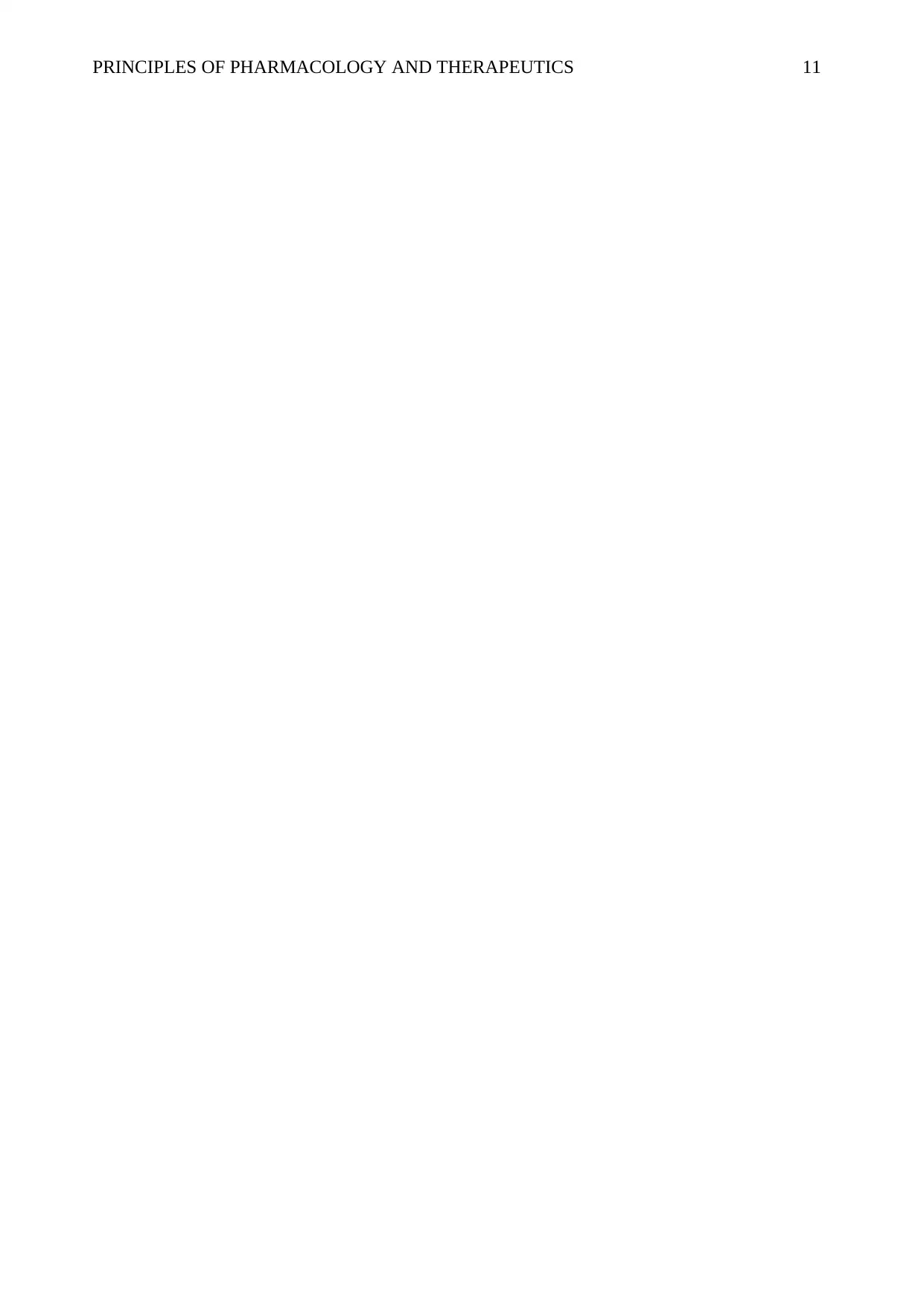
PRINCIPLES OF PHARMACOLOGY AND THERAPEUTICS 11
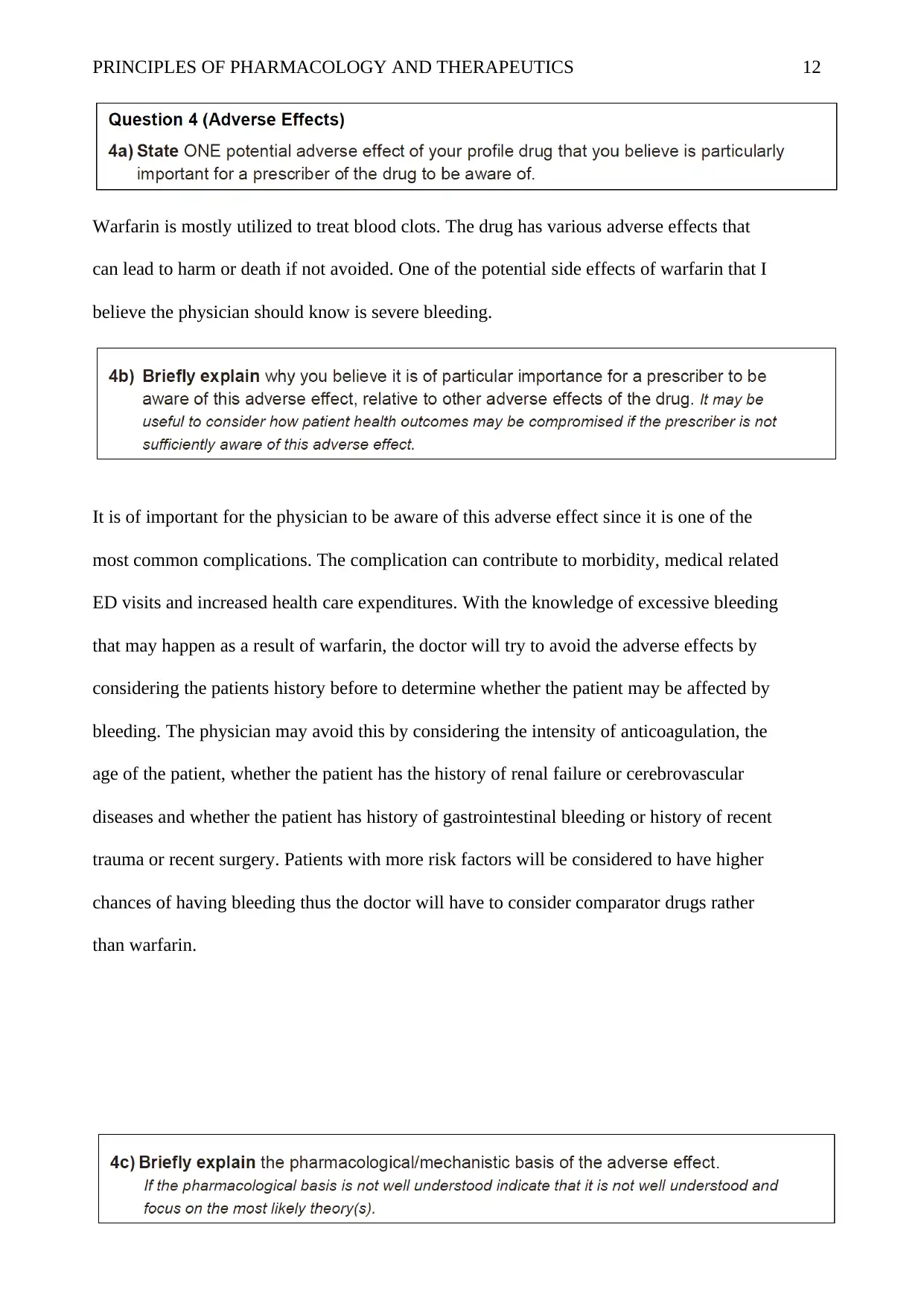
PRINCIPLES OF PHARMACOLOGY AND THERAPEUTICS 12
Warfarin is mostly utilized to treat blood clots. The drug has various adverse effects that
can lead to harm or death if not avoided. One of the potential side effects of warfarin that I
believe the physician should know is severe bleeding.
It is of important for the physician to be aware of this adverse effect since it is one of the
most common complications. The complication can contribute to morbidity, medical related
ED visits and increased health care expenditures. With the knowledge of excessive bleeding
that may happen as a result of warfarin, the doctor will try to avoid the adverse effects by
considering the patients history before to determine whether the patient may be affected by
bleeding. The physician may avoid this by considering the intensity of anticoagulation, the
age of the patient, whether the patient has the history of renal failure or cerebrovascular
diseases and whether the patient has history of gastrointestinal bleeding or history of recent
trauma or recent surgery. Patients with more risk factors will be considered to have higher
chances of having bleeding thus the doctor will have to consider comparator drugs rather
than warfarin.
Warfarin is mostly utilized to treat blood clots. The drug has various adverse effects that
can lead to harm or death if not avoided. One of the potential side effects of warfarin that I
believe the physician should know is severe bleeding.
It is of important for the physician to be aware of this adverse effect since it is one of the
most common complications. The complication can contribute to morbidity, medical related
ED visits and increased health care expenditures. With the knowledge of excessive bleeding
that may happen as a result of warfarin, the doctor will try to avoid the adverse effects by
considering the patients history before to determine whether the patient may be affected by
bleeding. The physician may avoid this by considering the intensity of anticoagulation, the
age of the patient, whether the patient has the history of renal failure or cerebrovascular
diseases and whether the patient has history of gastrointestinal bleeding or history of recent
trauma or recent surgery. Patients with more risk factors will be considered to have higher
chances of having bleeding thus the doctor will have to consider comparator drugs rather
than warfarin.
⊘ This is a preview!⊘
Do you want full access?
Subscribe today to unlock all pages.

Trusted by 1+ million students worldwide
1 out of 27
Your All-in-One AI-Powered Toolkit for Academic Success.
+13062052269
info@desklib.com
Available 24*7 on WhatsApp / Email
![[object Object]](/_next/static/media/star-bottom.7253800d.svg)
Unlock your academic potential
Copyright © 2020–2026 A2Z Services. All Rights Reserved. Developed and managed by ZUCOL.


